Celebrating Community and Comradeship While Remembering the Sacrifice of Our Brave Service Members in Palm Springs
The American Legion, founded in 1919, is a U.S. wartime veterans organization created to support military veterans and their communities. After World War I, a group of American servicemen stationed in France gathered in Paris in March 1919 to discuss forming a veterans’ organization. They aimed to provide a supportive network for veterans returning home and to advocate for veterans' rights. By May 1919, Congress chartered the American Legion, giving it an official role in the U.S.
American Legion posts were quickly established across the country to serve as community hubs for veterans. Each post offers veterans a place to connect, share experiences, and access resources like healthcare, educational support, and job training. Posts also engage in local community service, working to support veterans, military families, and youth programs, including scholarships and leadership programs.
American Legion Post in Palm Springs
An American Legion Post has been part of Palm Springs since 1934. Earl Coffman, a WWI veteran and owner of the Desert Inn, was the founder of the business, along with his wife, Nellie Coffman. Early meetings were held at the Desert Inn, which was then moved to The Duggout during WWII, which served those on inactive duty during the war.
American Legion Post 519 in Palm Springs is a historic post with a strong presence in the Coachella Valley community. Founded in 1947, the post was established to support veterans returning from World War II and to offer a welcoming place for veterans of all backgrounds to gather, socialize, and find camaraderie.
Post WWII
Shortly after World War II, the American Legion began plans to establish a lasting memorial in Palm Springs, one that would serve as both a tribute to the fallen and a gathering place for veterans. The initiative gained significant community support, including donations of land by Nellie Coffman and Pearl McManus, both prominent Palm Springs pioneers. Construction of the memorial building began in the summer of 1947, led by local contractor Ryland Pinkard, who was personally invested in the project; his son, Platoon Sergeant Earle Pinkard, a U.S. Marine, had been killed in Saipan in 1944.
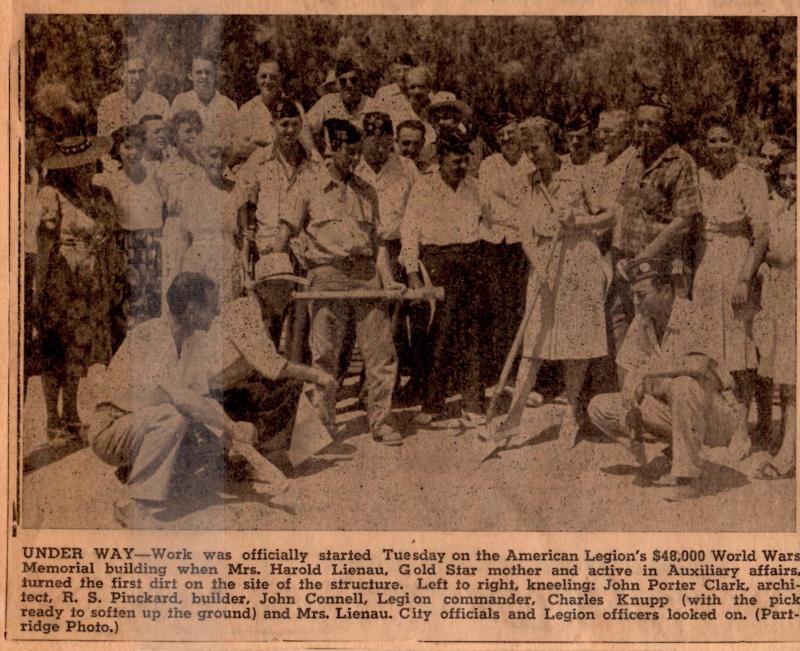
The architectural design was entrusted to John Porter Clark and Albert Frey, both influential figures in the mid-century modern movement. The building at 400 N. Belardo Road showcases early modernist design, blending clean lines with practical features suited to the desert environment. A standout architectural element is the "Lamella" ceiling, a unique and now-rare structural feature that reflects innovation in design and has become a rarity in Southern California buildings. This ceiling is currently not visible and is planned to be restored.
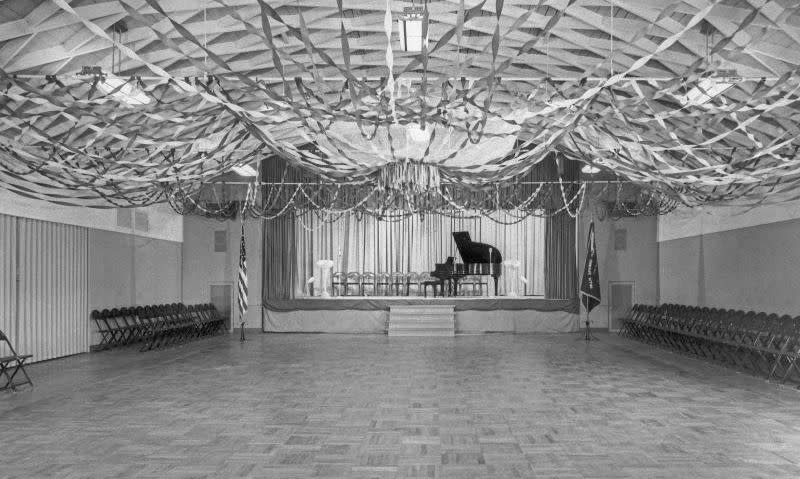
Owen Coffman
On April 21, 1944, 2nd Lt. Owen Baylis Coffman, a graduate of Banning High School's class of 1938 and Stanford University’s class of 1943, was killed in action when his B-17 bomber crashed near Horham, England, while flying into a storm. Owen was the first native-born resident of Palm Springs to give his life in service to the country. A downdraft forced his plane toward the ground, and as he attempted to pull out, it broke in two. Tragically, seven men were killed, with only three managing to bail out. This was only Owen's second mission.
Owen came from a prominent Palm Springs family. His father, Earl Coffman, was a World War I veteran and founder of the American Legion. His grandmother, Nellie Coffman, owned the Desert Inn, one of the most prominent resorts in the U.S., which hosted Hollywood stars, industry leaders, and dignitaries. Owen is buried at the American Military Cemetery in Cambridge, England. In May 1944, the Palm Springs American Legion Post 519 was named in his honor.
Numerous articles in the Desert Sun chronicled Owen's life, celebrating his 18th birthday, detailing his enlistment, documenting his journey to earn his pilot's wings, recounting a final visit to Palm Springs, and reporting the tragic news of his crash.
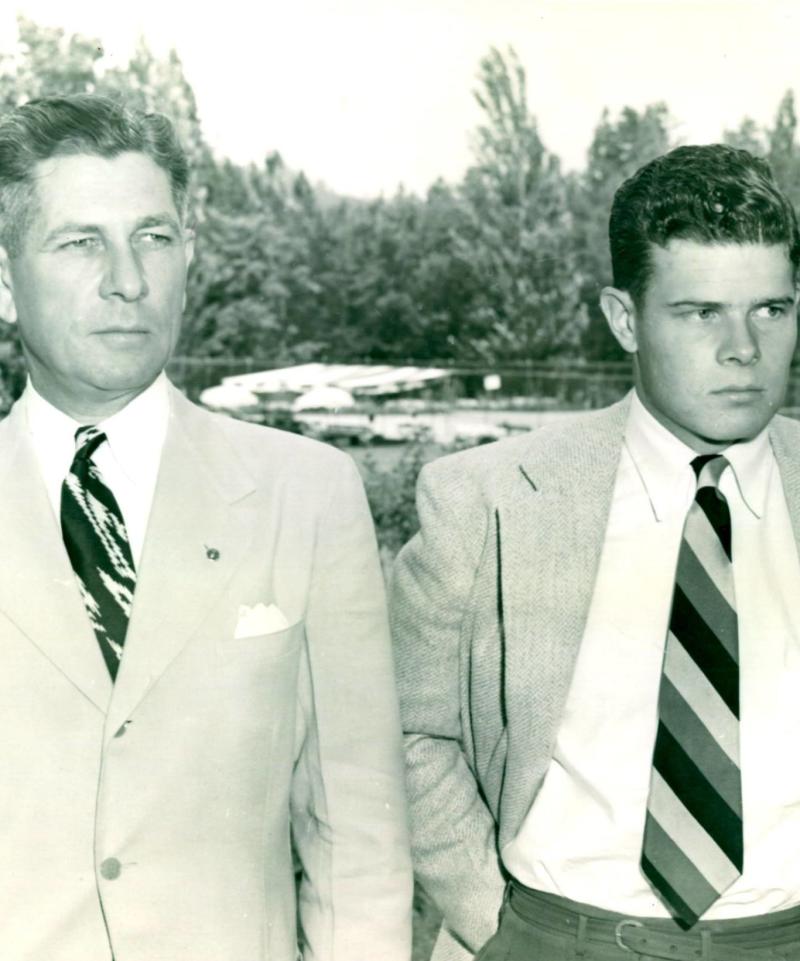
Earl Coffman, owner of the Desert Inn and founder of the Palm Springs American Legion with his son, Owen Coffman
His portrait, painted by renowned local artist Axel Linus, is displayed at the legion.
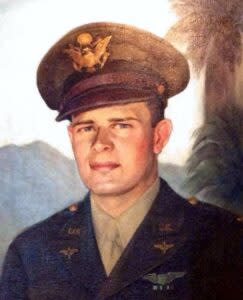
Early Radio Days
In the early days of live radio, all broadcasts took place on stage, a setting that captivated audiences in an era before television. This unique format was essential, as radio was the only real-time medium, making big bands and live performances a significant draw. Only the grandest venues across the country were equipped to handle the technical demands of live radio broadcasts. At the time, there were just two recording studios in the country—one in Los Angeles and one in New York—but the stars were increasingly drawn to Palm Springs. From the Rat Pack to Doris Day and David Niven, an impressive array of celebrities made their way to the desert.
To accommodate this influx, the American Legion Hall in Palm Springs was chosen as the broadcast center. In the 1940s, both ABC and CBS saw its potential and outfitted it to handle live broadcasts. Signals were transmitted through phone lines to Burbank and Los Angeles, then relayed across the nation on a powerful 50,000-watt transmitter, making Palm Springs a prominent location in American entertainment.
Soon, Palm Springs became synonymous with celebrity glamour. Icons such as Bob Hope, Bing Crosby, Jack Benny, Cary Grant, Groucho Marx, Al Jolson, and Eddie Cantor graced the halls of the Legion, adding to its legacy. These frequent appearances cemented the city’s status as a hot spot for the entertainment elite and a landmark in radio history.
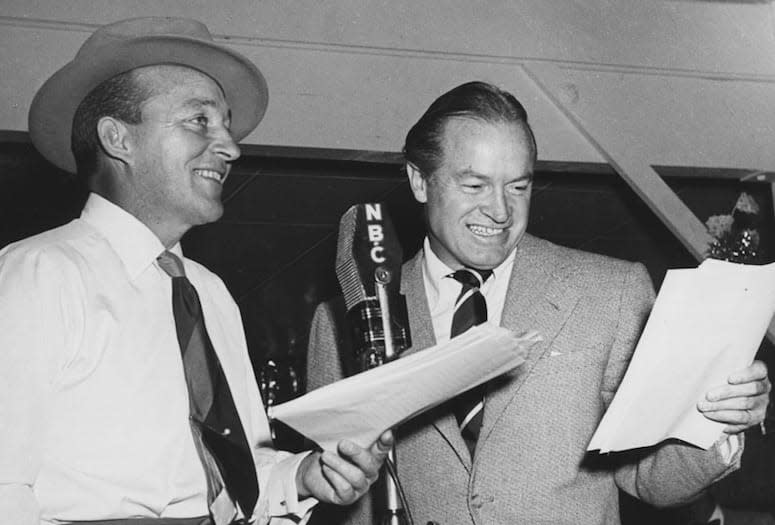
Bing Crosby and Bob Hope share the NBC microphone stationed at the American Legion Post No. 519 to broadcast the Kraft Music Hall variety show.
Listen to a Kraft Music Hall snippet broadcast from the American Legion Post No. 519 starring Al Jolson.
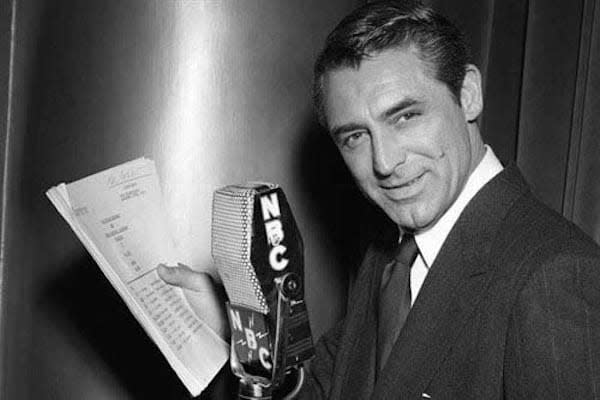
Cary Grant was one of the movie stars who participated in the American Legion Post No. 519 live broadcasts.
Music is the Key of Life
Just outside the radio booth, priceless wonder dominates the American Legion 519 stage. The Legion has the 1905 Salon Grand Steinway that Al Jolson, Jack Benny, and all those guys played on our piano.

Judy Garland, Al Jolson, and pianist Oscar Levant were on stage at Post 519, playing on our 1905 Steinway.
Legion Member Claudette Bradley is credited with preserving the Steinway. She was a classically trained Marine Corps pianist who played for President Carter at the White House.
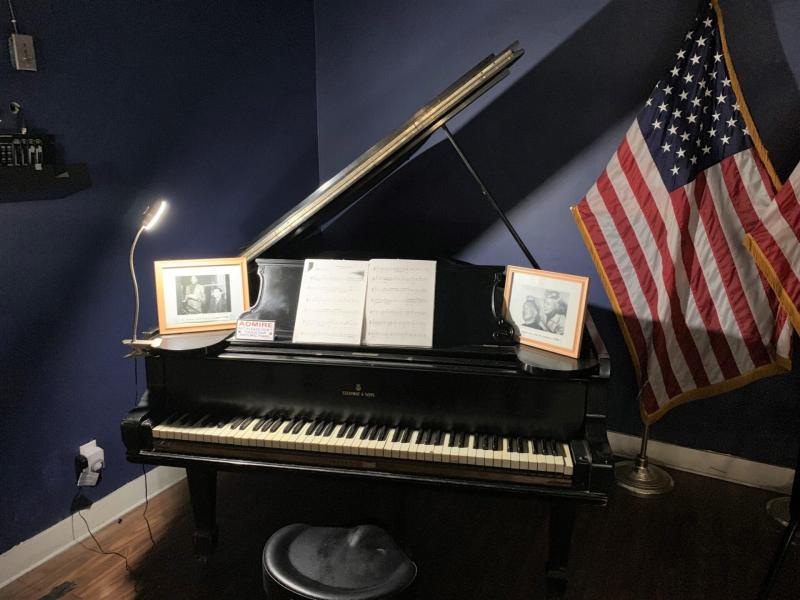
American Legion 519 is not just for Veterans
Even though the American Legion Hall is a private membership club open to veterans and their friends and family, it also hosts events for the public. Non-veterans may need to be accompanied by a member. Generally, they will post if an event is open to the public and if there are any special rules that need to be followed.

Tribute to Local Fallen Heroes
On November 10, 1942, the Marine Corps Birthday, PFC Richard Francis Gill, USMC, became the first person from the Palm Springs area to lose his life in service to our country. Gill's family moved to Palm Springs in the late 1930s. Richard worked at a local restaurant and enlisted in the Marines just ten days after the attack on Pearl Harbor. After a final visit home, he was deployed to the Solomon Islands. Richard was killed during a firefight with Japanese forces and was reported missing in action on Guadalcanal.
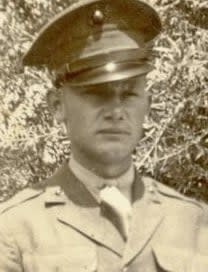
On January 24, 1943, Norval "Bill" William Kelley Jr. became the first Palm Springs High School graduate (1940) to give his life in service to our country. The Kelley family ran a laundromat downtown. PSHS had just been built. Bill was a 2nd LT and a navigator on a B-17. Prior to his deployment overseas, he was on a training mission with several other navigators when they ran into a storm over Colorado. Witnesses say they saw the plane cartwheel into the ground. All 10 on board were killed.
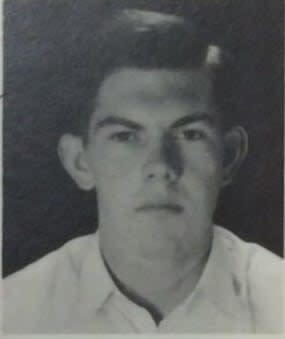
On November 27, 1944, Sgt. Allen Hall Jr., a Marine and graduate of Palm Springs High School's Class of 1941, was killed in action when his battleship, the USS Colorado (BB-45), was struck by a kamikaze attack. This incident resulted in the deaths of 19 crew members and injured 72 others. Sgt. Hall had previously been wounded during the 1943 invasion of Tinian. At the time of the attack, he was manning his anti-aircraft position with the Marine detachment when the kamikaze hit his gun. Allen was also known for his role in the military film "Wake Island," which was filmed near the Salton Sea and came out in 1942. His brother, Bill, served on a minesweeper during the Normandy invasion on D-Day.
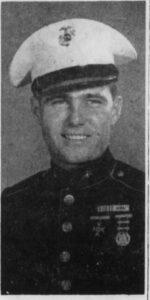
In 1944, PFC Stephen Joseph Levi, a U.S. Marine and Palm Springs High School graduate, was killed in action during the Battle of Saipan. Born on the Torres-Martinez Reservation and later adopted by Palm Springs resident Fannie May Marcus, Stephen graduated in 1943, excelling in sports. He had previously fought at Tarawa before joining the fierce fighting in Saipan. In the battle’s final days, Stephen was among those who faced the last desperate “Banzai” attack by Japanese forces, which broke through American lines, resulting in hundreds of casualties. Stephen, a radio operator, lost his life in that assault. The next day, Saipan was secured.

On December 11, 1944, Sgt. Herbert Harold Lienau, a graduate of Palm Springs High School's Class of 1943, was killed in action when his B-24 Liberator bomber was shot down after returning from a mission near Hanau, Germany. Sgt. Lienau was an accomplished student-athlete and an Eagle Scout and received several awards during his training. He served as the tail gunner of the 491st Bomber Group.
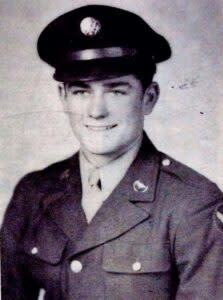
On December 20, 1944, SSGT Pete Nila, PSHS class of 1942, was killed in action. Following a mission to bomb a chemical factory in Czechoslovakia, Pete's B-24 and his group flew into a storm, returning to their base in Italy. Five aircraft were lost. Pete's bomber flew directly into a mountain, killing all on board.

PFC Thomas (Tomas) Villa was killed in action on February 20, 1945, during the liberation of Corregidor, The Philippines. Tomas lived at the Plaza Theater Apartments on Palm Canyon Drive. He worked for Nellie Coffman at the Desert Inn, first as a bellboy and then as the gardener.
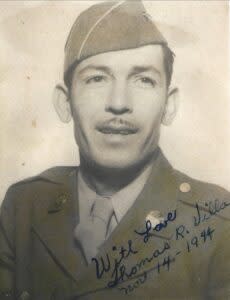
On June 24, 1944, Platoon Sergeant Earle B. Pinckard, a Palm Springs resident, was killed in action while assaulting Garapan, Saipan. Known as the local "Rambo," Earle had a courageous record of service. Before the war, he served in the Merchant Marines and later enlisted in the Marine Corps, where he fought at Guadalcanal. He was wounded at Tarawa in November 1943 and ultimately lost his life to a mortar round on Saipan. Earle’s father, Ryland Pinckard, a local contractor, won the bid to build the Palm Springs American Legion Hall, purposely bidding low to honor his son’s legacy. In 1948, Earle was brought home and laid to rest beside his parents at Welwood Cemetery.

On June 22, 1945, PFC David Kester Manson became the last person with Palm Springs ties to give his life in World War II. At just 19 years old, David was also the youngest person in the area to make this sacrifice. His name, along with those of 15 others who fell during the war, is memorialized on the Palm Springs American Legion Post 519 Memorial Wall. David registered for the draft on his 18th birthday in 1944. His father, Mahlon Manson, worked as a chemist in the war industry and later moved to Palm Springs, where the family ran the Vista del Sol apartments on North Indian Canyon. David’s sister, Martha Lou Manson, graduated from UCLA in 1948 and went on to manage the children's section of the Welwood Murray Library. David was killed near the Ipo Dam area north of Manila.
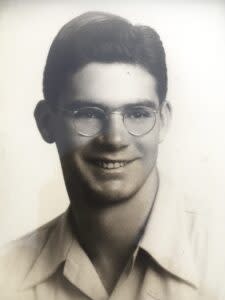
On January 30, 1951, Russell Garcia Torres, a resident of Palm Springs, was killed in action while fighting near Subuk, South Korea. He was the only local to lose his life during the Korean War. He was drafted into the Army during World War II and served in combat in the Philippines. After the war, he joined the American occupation forces in South Korea. When North Korea invaded, Russell's unit was sent to the front lines near the Pusan Perimeter. Sgt. Torres served is buried at Welwood-Murray Cemetery.
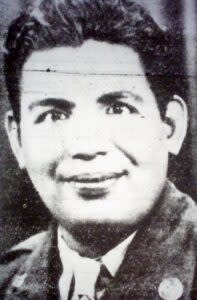
On July 6, 1967, Corporal Thomas Eugene McKee became the first Palm Springs resident to lose his life in the Vietnam War. At just 20 years old, Thomas, an M48 tank crewman, was killed while attempting to tow a disabled vehicle. Despite being twice wounded before, he demonstrated bravery that earned him a Silver Star, awarded shortly before he passed away in a Navy hospital in the Philippines. Thomas was laid to rest with full military honors at Desert Memorial Park in Cathedral City. He is commemorated with a banner at the Palm Springs Air Museum.
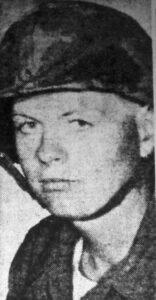
On March 11, 1968, PFC Dennis Dale Reed, Palm Springs High School class of 1966, was killed in action in Thua Thien Province, Republic of Vietnam. Dennis worked at the Market Basket grocery store across the street from PSHS at the old Palm Springs Mall (demolished).
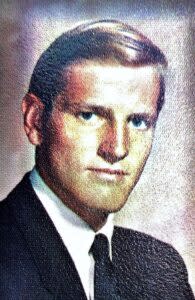
On February 27, 1969, SPC4 Robert Phillip Levin, PSHS class of 1966, was killed in action following a firefight with Communist forces in Vietnam. Robert earned the Silver Star. His unit was engaged in a heavy firefight, and despite being wounded, Robert continued to attack Viet Cong positions before he received his fatal wound. The Levin family was well known in Palm Springs, for they owned the Biltmore Hotel (demolished). Robert is buried at the Desert Memorial Park in Cathedral City.

On April 30, 1968, PFC Adam Serna Najar, USMC, became the fourth resident of the Palm Springs area to give his life in service to our country during the Vietnam War. A native of Texas, the Najar family moved to Palm Springs, where Adam attended school. Adam graduated PSHS in 1965 and briefly studied at College of the Desert before enlisting in the Marines. Adam's unit was on an operation to clear communist forces from the Khe Sanh area towards the end of the Tet Offensive when his unit came under fire, and he was killed. He is buried at Desert Memorial Park in Cathedral City.
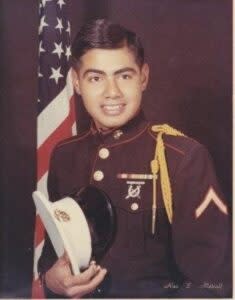
On September 21, 1968, Sgt. Leveret Roscoe Prosky, a 1966 graduate of Palm Springs High School, was killed in action during the Vietnam War. Leveret served one tour as a combat engineer and then volunteered for a second tour, where he worked as a door gunner on a UH-1 Huey helicopter. On September 21, while evacuating wounded soldiers in Quang Tri province, his helicopter was hit by an RPG and was shot down. While the rest of the crew was wounded, Leveret was killed instantly. His father worked at the Palm Springs post office, and Leveret is buried at Desert Memorial Park in Cathedral City.
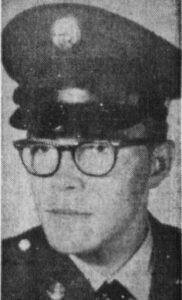
Special credit to Lee Wilson Jr. for all his work researching information about our local fallen soldiers.